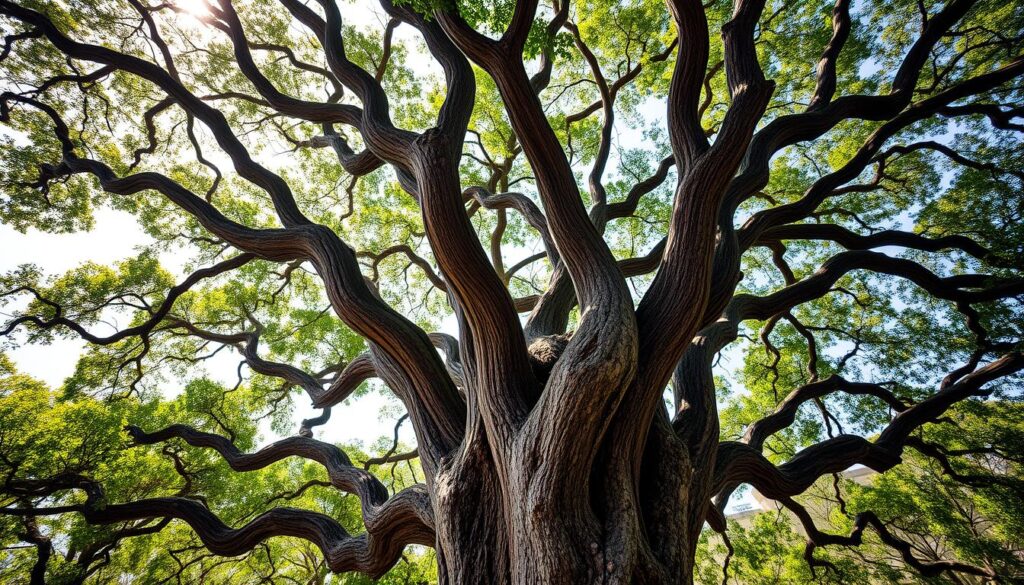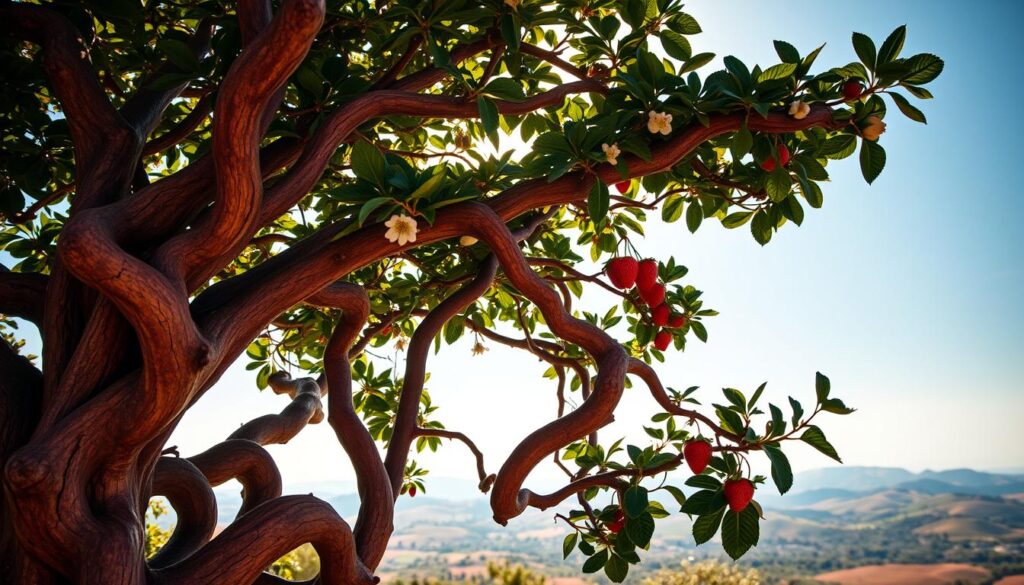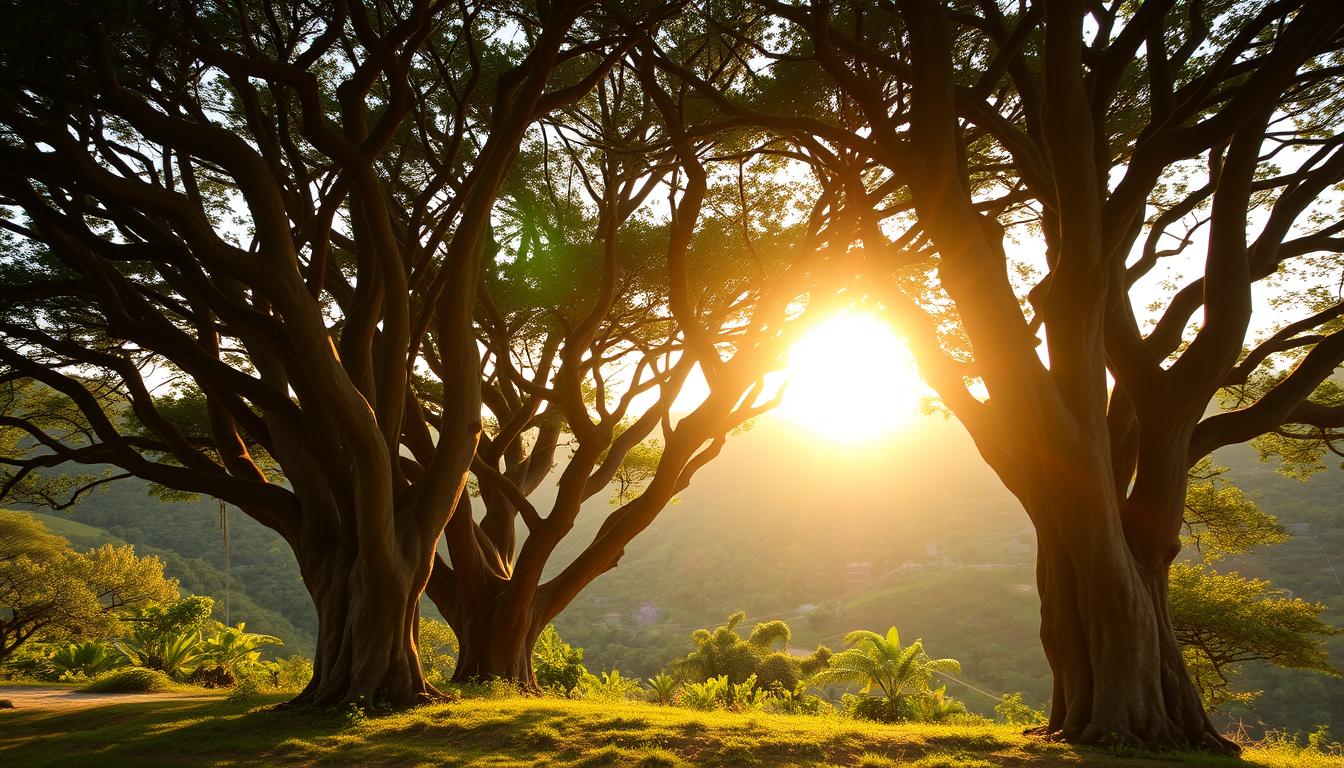Imagine turning your garden into a living canvas. Multi trunk trees are not just plants; they’re living sculptures. They bring artistry to every landscape with their twisted trunks.
These trees create visual symphonies that capture the eye and soul. They offer a dynamic alternative to traditional single-trunk trees.
As a landscape enthusiast, you’ll see how multi trunk trees can change your outdoor spaces. Their unique growth patterns add interest all year. From delicate spring blossoms to dramatic winter silhouettes, they are nature’s architectural wonders.
Whether you’re a seasoned gardener or a weekend landscaper, multi trunk trees are magical. They unlock new design possibilities. We’ll look at six exceptional trees that will make your landscape stand out.
Table of Contents
Understanding the Appeal of Multi-Stem Trees
Multi-stem trees are nature’s most captivating wonders, turning ordinary landscapes into living art galleries. They offer a unique approach to garden design. This creates natural sculptures that grab attention all year round.
Landscape designers and garden lovers are increasingly drawn to these trees. They have exceptional visual qualities. Unlike single-trunk trees, multi-stem trees bring a more dynamic and intricate look.
The Natural Beauty of Multiple Trunks
The beauty of multi-stem trees lies in their organic complexity. Their intricate branching patterns create a mesmerizing silhouette. It looks like living bonsai art.
Key visual attributes include:
- Unique structural forms
- Elegant branching patterns
- Textural Bark Variations
- Graceful movement in the wind
Benefits of Modern Landscaping
Multi-stem trees are great for modern outdoor spaces. They work well in small gardens, adding depth without taking up too much space. Their versatility allows for creative placement and design flexibility.
Artistic Value Throughout Seasons
These trees are dynamic landscape elements, changing with each season. From spring’s delicate blossoms to winter’s stark silhouettes, they offer continuous visual interest. Traditional trees can’t match this.
A multi-stem tree is not just a plant, but a living sculpture that evolves with time.
The Science Behind Multi Trunk Trees
Multi trunk trees are nature’s amazing creations. They grow in ways that show how trees can adapt to tough environments. Learning about their growth helps us see how genes and the environment work together.
The formation of multi trunk trees happens in a few main ways:
- Genetic inheritance that promotes multiple stem development
- Environmental stress responses
- Damage from external factors like wind, snow, or animal interactions
- Strategic pruning techniques
These trees have special ways of surviving. Some grow multiple trunks to protect themselves from harm. This helps them stay strong and share resources among their stems.
Genes are key in deciding if a tree will grow multiple trunks. Some trees are more likely to do this, depending on where they grow.
Nature’s most extraordinary trees are often those that have adapted most creatively to their surroundings.
Knowing how multi trunk trees grow makes us appreciate their beauty and strength. They show how plants can thrive in many places, whether naturally or through care.
Japanese Maple: Nature’s Living Sculpture
Japanese maples are amazing living sculptures that turn gardens into stunning works of art. They have beautiful, twisted trunks and change colors with the seasons.
If you love elegance and drama in your garden, Japanese maples are perfect. They offer a unique view all year round. This makes them a favorite for garden designs.
Coral Bark Varieties: A Vibrant Spectacle
The coral bark varieties, like Acer palmatum ‘Sango-kaku’, are eye-catching in any garden. Their bright coral-red bark is a highlight in winter when other plants are asleep.
- Vibrant coral-red bark
- Striking winter color
- Compact growth habit
Optimal Growing Conditions
To grow these living sculptures well, you need to create the right environment. Japanese maples do best in:
| Growing Requirement | Ideal Condition |
|---|---|
| Sunlight | Partial shade |
| Soil pH | Slightly acidic (5.5-6.5) |
| Moisture | Well-drained, consistent moisture |
Seasonal Color Transformations
Japanese maples are known for their amazing color changes. They start with soft greens in spring and then turn vibrant in summer. In autumn, they show off brilliant reds.
“A Japanese maple is not just a tree, but a living painting that changes with each passing season.” – Garden Design Expert
Crape Myrtle: Southern Charm Personified

Crape myrtles are standout multi trunk trees that add Southern charm to any garden. They turn your garden into a living art piece, offering year-round interest. Native to warm areas, they create stunning focal points with their unique bark and elegant shape.
These trees are known for their special features:
- Smooth, mottled bark that peels to reveal intricate patterns
- Ability to grow as multi-stem specimens
- Vibrant summer flower displays
- Attractive winter silhouettes
Choosing the right variety is key when adding these trees to your garden. Some grow compact, while others become larger and more dramatic. Their flexibility lets gardeners create beautiful scenes that change with the seasons.
Experts suggest pruning crape myrtles carefully to highlight their multi-trunk beauty. Careful shaping turns these trees into living sculptures that add beauty to gardens all year in warmer climates.
The art of growing crape myrtles is in understanding their natural growth and working with their beauty.
Multi Trunk Trees: Essential Care Guidelines
Caring for trees with multiple trunks needs special knowledge and attention. These trees require a careful maintenance plan, different from single-trunk trees. Knowing their specific needs helps keep them beautiful and healthy for a long time.
For these trees to thrive, several important factors must be considered. These factors greatly affect their health and beauty.
Soil Requirements for Healthy Growth
Your multi-trunk trees need well-draining soil with the right nutrients. Here are some key soil tips:
- Test soil pH before planting
- Ensure rich, organic content
- Maintain proper drainage
- Use mulch to retain moisture
Strategic Watering Approach
Watering multi-trunk trees needs a careful plan. Different trees have different water needs based on their size, age, and environment.
- Water deeply but infrequently
- Check soil moisture before watering
- Adjust frequency with seasonal changes
- Use drip irrigation for consistent moisture
Precision Pruning Techniques
Pruning is key to keeping multi-trunk trees looking great. Use techniques that keep their natural shape while encouraging growth.
- Remove crossing or damaged branches
- Maintain balanced trunk development
- Prune during dormant seasons
- Use clean, sharp pruning tools
Following these care tips will help your multi-trunk trees stay beautiful in your landscape for many years.
River Birch: Peeling Beauty
River birch trees are true wonders of nature. Their unique peeling bark makes them stand out. They turn simple gardens into breathtaking works of art.
Adding a river birch to your landscape is a smart move. These trees grow with twisted trunks that look amazing as they age. Their bark changes colors, showing off cream, cinnamon, and salmon hues all year.
- Native to North American riverbanks
- Adaptable to various soil conditions
- Thrives in both wet and moderately dry environments
- Excellent for urban and natural landscapes
Think about getting a river birch that can grow with multiple trunks. Prune it early to help it grow this way. It’s perfect for adding unique touches to your garden.
Keeping a river birch healthy is easy. They love full sun to partial shade and need regular water, especially when they’re young. Their beauty and hardiness make them a favorite among landscapers and garden lovers.
“The river birch transforms landscapes with its stunning, paper-like bark that seems to tell a story of natural beauty and resilience.” – Landscape Design Quarterly
Choosing the Perfect Location for Multi-Stem Specimens
Creating a stunning landscape with unique tree forms requires careful planning and strategic placement. Multi-stem trees are natural sculptures that can transform your outdoor space when positioned thoughtfully. These arboricultural wonders demand specific environmental conditions to thrive and showcase their full potential.
Selecting the right location involves several critical considerations that will determine the long-term success of your multi-trunk trees.
Space Requirements
Before planting, evaluate the mature size of your chosen multi-stem tree. Different species have varying growth patterns and spatial needs. Consider these key factors:
- Distance from structures
- Overhead power lines
- Underground utility zones
- Proximity to other landscape elements
Sunlight Exposure
Light plays a crucial role in the health and appearance of multi-trunk trees. Most specimens require:
- Full sun (6-8 hours of direct sunlight)
- Partial shade for sensitive species
- Protection from harsh afternoon heat
Soil Preparation
Proper soil conditions are fundamental to establishing healthy multi-stem trees. Invest time in preparing a nutrient-rich environment that supports robust root development. Test your soil’s pH and drainage characteristics before planting.
A well-prepared site is the foundation of a thriving multi-trunk tree landscape.
Your careful selection and preparation will ensure these living sculptures become breathtaking focal points in your garden for years to come.
The Strawberry Tree: Mediterranean Elegance

The Strawberry Tree (Arbutus unedo) is a stunning addition to any garden. It comes from the Mediterranean and has a unique shape. This tree lets gardeners turn their outdoor spaces into living art.
This tree can make your garden look amazing. It has:
- Smooth, peeling bark that creates visual texture
- Evergreen foliage provides year-round interest
- Unique strawberry-like fruits that develop alongside delicate white flowers
Bonsai lovers like the Strawberry Tree for its shape. You can prune it to make it look like a work of art. It can become a highlight in your garden.
Experts say to plant it in well-draining soil and partial sun. It grows best in zones 7-10. This makes it perfect for warm places with mild winters.
“A living sculpture that changes with each passing season” – Landscape Design Monthly
The Strawberry Tree is great for adding beauty to your garden. It’s perfect for making a statement or creating a beautiful screen.
Four-Season Interest and Visual Impact
Multi trunk trees are nature’s masterpieces that change your landscape all year. These living sculptures add unique beauty from winter to autumn. They make your outdoor spaces lively and interesting in every season.
In winter, their twisted trunks become stunning architectural features. Their detailed branch structures and rough bark make beautiful silhouettes against snow or gray skies. Trees like river birch and Japanese maple stand out with their unique bark and elegant branches.
- Winter: Structural beauty and bark texture
- Spring: New growth and delicate blossoms
- Summer: Lush foliage and full canopies
- Autumn: Dramatic color transformations
In spring, these trees come alive with new energy. Delicate flowers and fresh green leaves add vibrant life to your landscape. Their unique branches create a natural art form that catches sunlight and makes beautiful shadows.
Summer brings fullness and depth to these trees. Dense foliage provides cooling shade and creates cozy garden spaces. Texture becomes a key design element as branches intertwine and leaves rustle in the breeze.
Autumn brings the most dramatic change. Leaves turn from deep greens to brilliant oranges, reds, and yellows. Your multi trunk trees become breathtaking focal points that command attention and celebrate the season’s natural beauty.
Design Tips for Multi Trunk Tree Integration
Adding multi trunk trees to your landscape can make it truly special. These trees come in unique shapes that add beauty to any garden.
Placing multi trunk trees wisely can boost your landscape’s look. Here are some important design tips to keep in mind:
Landscape Planning Strategies
- Use multi trunk trees as dramatic focal points in open spaces
- Create visual layers by mixing tree heights and trunk configurations
- Select specimens that complement your existing landscape architecture
Companion Planting Techniques
Pairing multi trunk trees with the right plants can make them even more stunning. Here are some expert tips:
- Plant low-growing perennials around the base to soften trunk transitions
- Choose understory plants that thrive in dappled shade
- Select ground covers that highlight the tree’s unique trunk structure
Lighting Considerations
Lighting up your multi trunk trees can make your garden look amazing at night. The right lighting can turn these natural wonders into evening spectacles.
- Use upward-facing spotlights to highlight trunk textures
- Install soft ambient lighting for gentle nighttime illumination
- Experiment with colored lights to create dramatic effects
By carefully adding multi trunk trees, you’ll create a landscape that celebrates nature’s beauty. It will be interesting all year round.
Conclusion
Multi trunk trees are living sculptures that make ordinary landscapes into something special. They add more than just beauty to your garden. They change with the seasons, offering a dynamic visual experience.
The six multi trunk trees we looked at are great for gardeners wanting unique landscapes. From the Japanese Maple to the River Birch, each tree has its own charm. They turn your garden into a canvas with depth and intrigue.
Choosing multi trunk trees is not just about beauty. They help local ecosystems, provide homes for wildlife, and make gardens more resilient. They’re perfect for both small urban gardens and larger landscapes, blending beauty with function.
Your garden can show off nature’s creativity with these amazing trees. They’re not just plants; they’re living art that connects us to nature. They inspire, nurture, and transform our outdoor spaces.
FAQ
What exactly are multi trunk trees?
Multi trunk trees are special trees with two or more main stems. They grow from the base, making them unique and artistic. Unlike single-trunk trees, they have multiple trunks, either naturally or through pruning. This makes them stand out in gardens.
Are multi trunk trees difficult to maintain?
They need some special care but are easy to manage. You’ll need to prune them carefully to keep their shape. Make sure the trunks are spaced right and give them the right soil and water.
Can multi trunk trees work in small gardens?
Yes! They’re great for small spaces. Trees like Japanese Maples and compact Crape Myrtles work well. They add a lot of visual interest without taking up too much space.
How do environmental factors affect multi trunk tree growth?
The environment is key for these trees. Soil, light, climate, and genetics all affect their growth. Some trees are more adaptable, making them better for different places.
What are the best seasons for planting multi trunk trees?
The best times vary by tree type. Early spring or fall are usually best. These seasons have good weather and moisture for the trees to grow strong.
How long do multi trunk trees typically live?
Their lifespan varies by species and care. Trees like Japanese Maples and River Birches can live 50-100 years. With the right care, they become more interesting as they age.
Are multi trunk trees more expensive than traditional single-trunk trees?
Prices can differ. Multi trunk trees might cost a bit more due to the special pruning needed. But their unique look and year-round interest make them worth it for gardeners.
Can I create a multi trunk tree from an existing single-trunk tree?
It’s possible but hard. You can try to grow multiple trunks by pruning carefully. This involves removing some branches and letting others grow. But not all trees can be changed this way.
What are the ecological benefits of multi trunk trees?
They offer many benefits. They provide a habitat for wildlife, increase biodiversity, and help with photosynthesis. They’re also better at resisting wind and can cool cities. Plus, they help stabilize soil.
How do I prevent disease in multi trunk trees?
To prevent disease, ensure good air flow between trunks. Use proper pruning and sterilized tools, and watch for pests. Give them the right growing conditions. Regular checks and care are essential for their health.

